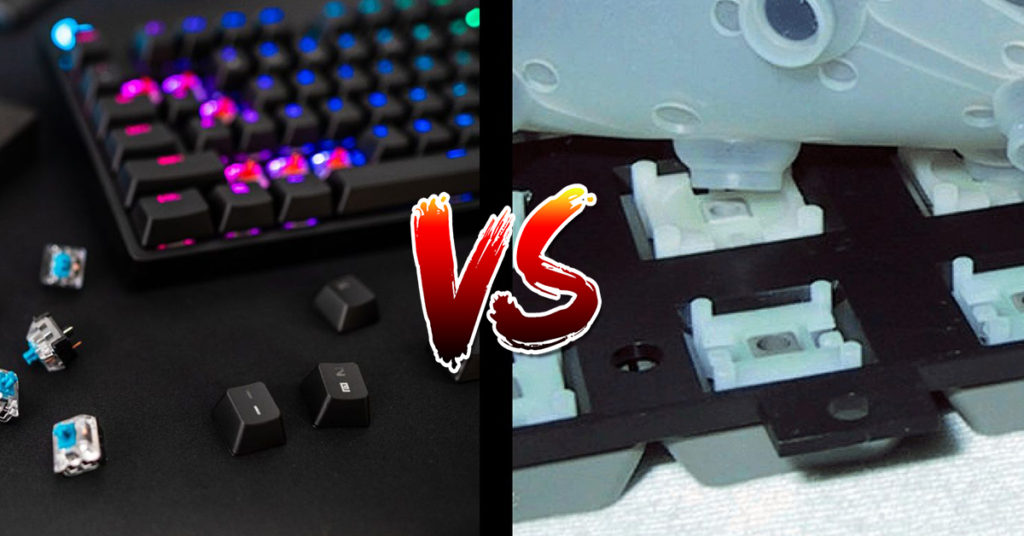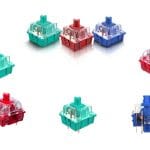
There are plenty of options when it comes to mechanical switches. However, at the end of the day, all MX Style switches are pretty similar. If you are looking for a different kind of switch, are optical switches the way to go?
Optical switches are technically superior to mechanical switches. They have a longer lifespan and have a faster response time. However, their biggest downfall is the variety of available switches. There are different manufacturers that are offering their own take on optical switches. But compared to mechanical switches, you are still not getting enough options to choose from.
In this article, we will dive deeper into the topic of mechanical switches and optical switches. We will be talking about their differences in more detail and we will help you decide which type of mechanical keyboard switch is for you.
Brief History of Mechanical Switches
Mechanical switches have been around for a very long time. The earliest form of a mechanical switch is the buckling spring keyboard which was introduced in the IBM Model M back in 1985. Since then, brands such as Cherry have patented the design and have created different mechanical switches such as the MX style switch.
However, when keyboard manufacturers wanted to simplify keyboard manufacturing in the late 90s, they scrapped mechanical keyboards and replaced them with membrane keyboards. This did not last long as gamers and enthusiasts wanted to have a better keyboard experience.
Mechanical keyboards made a resurgence in the late 2000s thanks to gaming brands such as Logitech G and Razer. And when Cherry’s patent on mechanical switches expired in 2014, it opened the doors for new manufacturers such as Kailh and Gateron to create new types of switches. This event also singlehandedly helped popularize the mechanical keyboard hobby.
Today, mechanical switches come in different flavors. The main three switch types are linear switches, tactile switches, and clicky switches.
To briefly describe them, clicky switches are the loud switches that provide tactile feedback. Tactile switches also provide a tactile bump but do not provide a clicky noise. And lastly, linear switches offer no tactile bump or audible feedback. You can learn more about switches in our detailed switch guide.
How Mechanical Switches Work
To actuate a Mechanical switch, two metal pieces have to make contact. This happens whenever a key is pressed. On the way down, the legs of the switch stop blocking the pathway between these two metal pieces thus, allowing them to make electric contact.
The way mechanical switches work have not changed since the 1990s. This may seem alright since MX style switches aren’t inherently flawed. However, they are also not perfect.
The main disadvantage of MX-style mechanical switches is the contact between the metals. The repeated contact can make this part wear out over time. Additionally, if you do not use the switches, they can oxidize over time.
Another downside to having metals having to make contact to actuate is having to wait for something called “debouncing” to happen. This is basically when the two thin metals make contact and vibrate.
The vibration needs to stop first before a key can actuate. This is generally not noticeable but is still a downside to mechanical switches.
What are Optical Switches?
Optical switches are very similar to mechanical switches both in terms of structure and feel. However, the actuation method is completely different. Unlike mechanical switches, optical switches do not rely on physical contact.
Instead, optical switches use light induction to trigger the switches. When a switch is pressed, it blocks a light beam that is emitted in the PCB. When this light beam is blocked, the actuated key registers.
Optical switches have several advantages. These include faster response time, a smoother feel, and increased durability.
Without direct contact, optical switches are theoretically faster and can already feel smooth without lubing. Also, since there are no metal parts inside, optical switches will not wear out easily and will have a longer lifespan compared to mechanical switches.
Optical Switch Manufacturers
Gateron Optical
Gateron optical switches are nearly identical to their mechanical counterparts. The only switch that is different in the optical version is the Gateron Optical Yellow. The rest of the switches should virtually feel similar.
Unfortunately, not all Gateron switches have an optical counterpart. Fan favorites such as the Gateron Ink Black and Milky series currently do not have an optical version. Overall, the options here are pretty basic considering how many switches Gateron offers.
Razer Optical
Razer is one of the few brands that have adopted the optical switch technology. But instead of slapping in a Razer logo to an already existing optical switch design and calling it a day, they had a completely different idea. Razer completely redesigned their MX Style switches
They have allowed for faster response times while maintaining the traditional stem for optimal keycap compatibility. But with that said, Razer’s optical switches do not have a lot of variety. Razer currently offers only a linear and clicky variant.
One thing that you have to take note of is that being an early adopter of a new kind of technology does not necessarily mean that the technology will be better. Razer themselves tried to introduce new ideas such as the Razer Edge that wasn’t too successful. So before you jump to optical switches, make sure to watch how the rest of the competition adapts first.
Which is The Better Switch?
Optical switches are without a doubt the better switch type. They offer better durability and faster response times. However, when it comes to switches, it’s not just about technical performance. At the end of the day, what makes a switch great is how it feels.
And in this case, most optical switches that are currently available feel very close to mechanical switches. In fact, Gateron optical switches are designed to replicate Gateron’s basic MX style switch offering.
Additionally, you do not have a large selection of optical switches. You will most certainly get tired of the basic offerings since there are no unique options.
Of course, like anything in the mechanical keyboard hobby, it is all about preference. If you are satisfied with optical switches, then there is no problem with using them.
And if you prefer MX-style mechanical switches better, then go for it. But overall, we believe that at their current state, optical switches are not better than traditional mechanical switches.

The KBE team is dedicated to sharing our knowledge and creating useful resources about computer keyboards. This article was written as a team collaboration, combining our knowledge and years of experience using, building and modding keyboards. Meet the team here.



